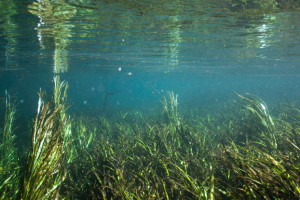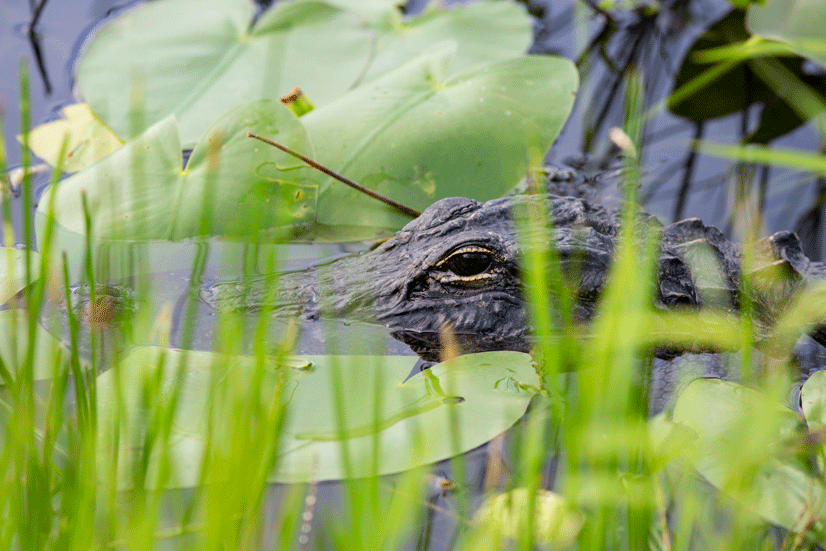Illinois pondweed (Potmagoeton illinoensis) is a Florida native aquatic plant that provides valuable aquatic habitat and forage for wildlife. Additionally, pondweed can act as a pioneer species in recovering lake ecosystems, increasing dissolved oxygen levels and helping anchor lake sediments. Pondweed, or pepper grass as it is also known, is an important part of our delicate and complex aquatic ecosystem.

Why is Pondweed Important?
Central Florida lakes are at their best when submerged aquatic plant species grow in a kind of underwater quilt. This so-called quilt depends on healthy “patches” of native species to grow, shift location, and provide an ever-changing underwater landscape. A healthy and diverse patchwork of native species provides habitat, open-water, and forage for fish and wildlife.
In a healthy Central Florida lake ecosystem, there will be a large variety of native aquatic plant species growing in this “quilt.” In other words, there will be large patches of pondweed, eelgrass, coon-tail, bladderwort, and other submersed native plants.
Species evenness, a calculation comparing biodiversity and the area of lake bottom covered by a species, fluctuates with annual conditions. Lake level, temperature, rainfall, etc. all play a part in which native plant species will grow well in any given year. This patch-work of native species helps prevent invasive species from moving in, increases the lake’s ability to buffer stormwater pollution, and improves the lake’s ability to rebound after disturbances like algae blooms, drought, or pollution-events.
Co-Existing with Pondweed
Illinois pondweed is a very beneficial native plant in Florida’s aquatic ecosystems. The long stems and floating leaves provide both wildlife forage and fish habitat, as well as help improve water clarity and quality. Without healthy pondweed populations and other native aquatic plant populations it would be easier for invasive plants, like hydrilla, to move in.

Pondweed becomes problematic for anglers and boaters when the plant grows to the surface of the lake, or in other words, “tops out.”
With exception to the occasional period of perfect conditions, pondweed tends to grow in small, dense patches which do not interfere with overall navigability or recreation on a lake. In other words, there will be some areas of the lake with a lot of pondweed but the majority of a healthy lake will still be navigable and enjoyable.
As a boater, familiarize yourself with what a lake surface with pondweed flowers looks like from afar. It blooms from spring through the fall and the small flower stalks are visible from a distance, popping up and out of the water. Avoid driving your boat through those areas, especially at slow speeds. If your propeller becomes choked up, take a moment to safely clear it before going on your way.
As an angler, the potential for fish habitat should not be undervalued. Use weedless lure setups, like the Texas-rigged worm or a swim-bait, to fish in areas with healthy pondweed stands. Alternatively, target areas just outside a pondweed patch and take advantage of the edge habitat.
Great. Pondweed is important, I get it. That doesn’t mean I have to like it.
It’s true; Illinois pondweed is not a popular plant.
However, the positive impact pondweed has on water quality and clarity should not be ignored. Healthy aquatic plant communities, which in Central Florida include patches of pondweed, are essential to healthy lakes. Healthy lakes are important to residents, tourism, the local economy, and to overall watershed health.

Residents who own the lakefront of their property can selectively remove pondweed, and other aquatic vegetation, from up to 50% or 50 feet of their lakefront, whichever is less. This “access corridor” can extend from shore out into open water. No permit is needed if the resident removes the plants by hand or with a rake or other hand tool.
Hand removal of overgrown aquatic plant material can be good for water quality, when done in moderation. Hand removal of aquatic plants physically removes excess nutrients from the lake.
Excess nutrients are the main cause of poor water quality in Central Florida. That said, I encourage residents to leave large patches of native plants on their lakefront to help improve water clarity and reduce erosion problems in the future. For more information, please feel free to contact me.
The only exception to this recommendation of hand-removal comes in relation to hydrilla and other vegetatively-spread invasive species. Hydrilla should not be removed by hand because breaking the stems up into smaller pieces can actually spread the plant. Each small piece of hydrilla which escapes removal can re-root and form a new individual plant. Please follow FWC’s rules and regulations to control hydrilla as it will usually require herbicide application.
Controlling Pondweed with Herbicide
Residents who would prefer to use herbicide for pondweed management will need a permit from Florida Fish and Wildlife Conservation Commission (FWC).
The FWC permit is easy to apply for, free and can be applied for online at: http://bitly.com/aquaticplantpermits. For questions related to the permit, call FWC at 863-534-7074.
Sources
- http://plants.ifas.ufl.edu/manage/why-manage-plants/non-native-invasive-plants-an-introduction/
- https://plants.ifas.ufl.edu/plant-directory/potamogeton-illinoensis/
- http://plants.ifas.ufl.edu/plant-directory/hydrilla-verticillata/
- http://plants.ifas.ufl.edu/manage/why-manage-plants/aquatic-and-wetland-plants-in-florida/
- https://myfwc.com/license/aquatic-plants/
Last update: June 2019
University of Florida IFAS Extension is committed to diversity of people, thought and opinion, to inclusiveness and to equal opportunity.
UF/IFAS Extension is an Equal Opportunity Institution.
 0
0
